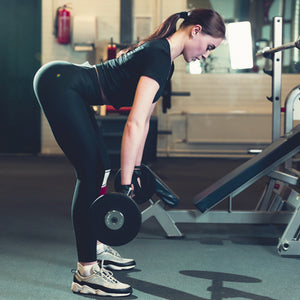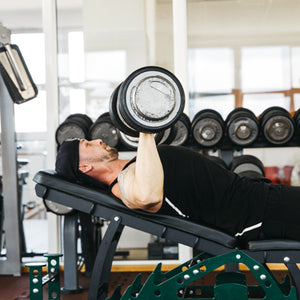
Lean Body 20ct.
Description
Here's what you get in every convenient packet of LEAN BODY:
- 40g LeanPro® Protein
- Award-Winning Taste! Aspartame-Free
- 8g FiberPlex™ Dietary Fiber
- 20 Packets per Container
Keeping the Anabolic Edge
by R.J. Fischer
Aside from intense training and sufficient rest, maintaining an anabolic state within the body is the most critical element for lean muscle growth. To achieve this state, and especially to keep it, bodybuilders must properly manage one of the body's most anabolic substances; insulin.
Insulin is produced by the pancreas in response to rises in blood sugar levels triggered primarily by the eating of sugars or carbohydrates. If the pancreas is over-stimulated it will produce too much insulin, which acts as a poison in the body. To protect itself, the body converts excess insulin to triglycerides which are stored as body fat1,2.In contrast, if not enough insulin is produced, muscle growth becomes very unlikely because insulin also regulates the transport of nutrients like amino acids into muscle cells for protein synthesis 3,4. Growth hormone, thyroid hormones, and testosterone all interact with insulin to properly do their jobs5. Bodybuilders can use insulin to work in their favor by learning how to manage it.
Those wishing to body build naturally and safely would be better served to learn how to manipulate their body's insulin levels through dietary means. Two keys to controlling insulin levels through the diet are meal frequency and food composition.
MEAL FREQUENCY
Every successful bodybuilder, from amateur to Olympian, eats at least six times per day. Successful bodybuilders know that by eating at least six meals per day, they provide their muscles with a steady stream of nutrients, keeping them in an anabolic environment. "Anabolic" refers to being in a positive balance of growth: for bodybuilders it means gaining more muscle than is being broken down naturally by the body through exercise and stress. The opposite of an anabolic state is a "catabolic" state, one in which there is a negative balance of growth. Since the body does not store protein the way it does fats or carbohydrates, it is essential that protein be provided to the muscles throughout the day for maximum benefit.
Eating six times per day (every 2 to 3 hours) not only helps in maintaining a positive nitrogen balance, but also prevents the body from dipping into its own muscle tissue to get nutrients like protein, and also keeps insulin levels stable, a requirement for proper fat metabolism.
In addition to eating every 2 to 3 hours, controlling the composition of the foods allows bodybuilders to better regulate their insulin levels.
FOOD COMPOSITION
Every bodybuilder should properly balance the composition of foods in their diets to effectively control insulin. This can be done by eating sufficient calories, maintaining a high protein diet, and consuming carbohydrates and fat in the right proportions.
SUFFICIENT CALORIES
To stay in an anabolic state, bodybuilders must consume an adequate amount of calories. Without an adequate amount of calories, the body enters a panic state of self-preservation. It basically begins to feed off of itself by using nutrients from its own tissues including muscle tissue. A good rule of thumb is to consume 12-15 times one's body weight in calories on a daily basis. For example, if a bodybuilder weighs 200 lbs. he should eat 2400-3000calories per day, depending on whether he is trying to lean down or puton weight. Of the calories consumed, 30-50% of them should come from protein. Without sufficient calories from protein, the body will shift from an anabolic state to a catabolic one as it starts tearing down muscle tissue to meet its metabolic needs for protein. Maintaining a diet rich in protein calories will help prevent the shift to a catabolic state.
PROTEIN CALORIES
In addition to preventing catabolic reactions in the body, consuming sufficient calories from protein has other advantages. Protein's ability to stimulate the metabolism through its thermic effect is one of them. Every time food is ingested, the body has to burn a certain number of calories just to digest the food ingested. Whenever protein is consumed, approximately 20% of the protein calories consumed are used for digestion and assimilation of the food3, 4. Protein has the greatest thermic effect on the metabolism; carbohydrate and fat have values of only 8% and 2%, respectively6. Bodybuilders canal so benefit from protein's effect on stabilizing insulin.
Protein influences insulin metabolism by stimulating the hormone glucagon. Glucagon helps to keep insulin in check because it governs excess insulin production by the pancreas. Protein's influence on metabolism is greatest when sufficient protein exists in the diet. To ensure having adequate protein in the diet, a hard training bodybuilder should consume at least one to one and a half grams of protein for every pound of body weight. For example, a 200 lb. bodybuilder should consume at least 200-300 grams of protein each day.
Finally, to balance the composition of foods in the diet, bodybuilders must pay special attention to the proportions of the other two macronutrients, carbohydrates and fat. These are responsible for "food energy". Sufficient calories from carbohydrates and fat means having protein spared for growth, instead of used for energy.
BALANCE OF PROPORTIONS
No matter what the goal, every bodybuilder should consume a diet high in protein, as described above, to make maximum gains.
Most bodybuilders fare well on high complex carbohydrate/low fat diets, typically 60% carbohydrate, 30% protein, and 10% fat. Most successful bodybuilders rely on this type of diet to gain muscle and lose fat. This type of diet works for most bodybuilders, most of the time. However, for those who make little or no gains on a high carbohydrate/low fat diet, just the opposite, a low carbohydrate/high fat diet is often the answer.
Adhering to the appropriate diet will give support to insulin metabolism which will facilitate gains in muscle size and fat loss. Both low carbohydrate and high carbohydrate diets require a great deal of planning to properly maintain the desired proportions.
COMPLIANCE
Counting calories and weighing and measuring food are all required to prepare body building meals that are high in protein, adequate in calories, and optimal in macronutrient profile. For years, bodybuilders had to discipline themselves in the kitchen, spending hours cooking and preparing the following day's meals to comply with these critical constraints. Toting a duffle-bag full of chicken breasts, tuna cans, rice, and potatoes was a necessary component of making muscular gains. It wasn't until recently that all of this became easier for bodybuilders.
ENTER MEAL REPLACEMENTS
In the early 90's so-called "engineered foods" or meal replacements became the bodybuilder's meal of choice. Finally, there was an easier way to get a meal high in protein, adequate in calories, and nutritionally dense without the inconvenience of weighing or cooking the food. Besides convenience, these new meal replacements offered bodybuilders other advantages.
BENEFITS OF THE "SUPER FOODS"
With the advent of meal replacements or "super foods," bodybuilders could now get all the nutrients they needed each day without popping a shelf-full of supplements. All of the essential protein, calories, and vitamins that a bodybuilder could want were now available in a convenient packet. No longer did bodybuilders need to calculate nutritional information for meals, the nutritional breakdown of the entire meal was right on the back of the packet. The boredom factor was greatly reduced, too. Instead of eating the same boring foods day after day, bodybuilders could now look forward to some added variety. Best of all, these meal replacements were among the first supplements to taste as good as milk shakes. Not only were these new super foods convenient and delicious, but they were also affordable.
The cost of this new type of "meal" averaged about $3.00 per packet. Factoring in the expense and time of cooking conventional meals, it was easy to see why meal replacements became so popular. Overnight, the bodybuilder's diet went from being dull and disciplined to exciting and varied. And with nutrition that could be more precisely controlled, insulin management became easier.
EVOLUTION OF MEAL REPLACEMENTS
First generation
In the early 90's Met-Rx Substrate Technology, Inc. started the meal replacement revolution with its Met-Rx? Engineered Food. Thirty-seven grams of protein per serving, the convenience of tear-open packets, and a great marketing effort helped change the way bodybuilders and athletes perceived their daily nutrition. The meal replacement was born.
By 1994, health food store shelves were packed not only with Met-Rx, but a half dozen copy-cat brands. However, none of the imitators had really improved on what Met-Rx had originally done. Not until recently, have meal replacements evolved to a higher level.
Second generation
Major advances in the meal replacement category have been made in recent years. The first major breakthrough came from Experimental and Applied Science, Inc. with its meal replacement, MyoPlex. This was the first meal replacement to cross the 40 grams of protein barrier. At 42 grams of protein per packet vs. 37 grams per packet for Met-Rx, MyoPlex contains almost 15% more protein than Met-Rx. Also making MyoPlex unique is its protein formula, which includes ion-exchange whey protein, a high quality form of whey protein. Higher protein and a higher quality protein were two things that made MyoPlex the best meal replacement that money could buy until just recently.
Third generation
Bodybuilders and athletes everywhere can now take advantage of the most recent breakthroughs in food science. This last year, a giant step forward in the meal replacement category was taken by two companies. Third generation meal replacements combine impressive nutrient profiles with delicious taste and higher protein. In early 1997, Labrada Bodybuilding Nutrition introduced its Lean Body meal replacement. At 40 grams of protein per serving, it contains 22% more protein than Met-Rx and 7% more protein than MyoPlex. Like MyoPlex, it contains ion exchange whey protein. But Lean Body also contains whey protein peptides in its protein profile, which have been shown to be more quickly absorbed than intact proteins. At only 200mg of sodium and 1 gram of fat, Lean Body also contains the lowest sodium and fat of all the meal replacements I've tried. Lean Body tastes delicious too. Labrada claims it tastes like soft vanilla ice cream. I don't know if it's as good as the soft serve ice cream, but I thought it was pretty darn good. Incidentally, Lean Body also gives the best "bang for the buck." (See comparison table) I calculated how much protein came in a box of each company's meal replacement, then compared that to the suggested retail price. The reason I chose protein is because it is where the real cost is in a meal replacement. Protein is what you pay for.
MESO-Tech is another third generation meal replacement worth mentioning. At 57 grams of protein per packet, it's the "bruiser" of the meal replacement category, but in my opinion, a bit overkill for most people. How many people do you know that can use 57 grams of protein in a meal, anyway? MESO-Tech TM claims it contains 10 grams of L-glutamine per serving. A drawback to MESO-Tech is its cost. At $66.99 for 14 packets, it was a little too expensive for my taste.
Another benefit bodybuilders can enjoy from both Lean Body and MESO-Tech is that they are made without insulin-inhibiting oils. Third generation meal replacements do not contain any partially-hydrogenated oils, perhaps because of recent studies which have shown that hydrogenated oils are especially harmful. One scientist, Dr. Udo Erasmus considered by many to be the leading expert on lipids and fats warns, "hydrogenated oils are counter-productive to what an athlete actually requires from the fats that they need in the diet. Hydrogenated oils actually cause weakness and low energy levels, interfere with liver detoxification, interfere with insulin function, decrease testosterone production and increase abnormal sperm count."7
In short, the new wave of meal replacements are a more sophisticated alternative. What's next? To see how meal replacements stack up against each other in protein content, price, and value, see the chart below.
CHART
| Brand | Protein per packet (grams) | Protein per box (grams) | Sugg. Ret. Price | Fat (grams) | Sodium (mg) | Value |
| Lean Body | 40 | 800 | $57.99 | 1 | 200 | Best value; most protein per box. Delicious ice cream taste. |
| MyoPlex | 42 | 840 | $54.95 | 2 | 330 | higher protein; good value |
| Meso Tech | 57 | 798 | $66.99 | 2 | 220 | highest protein per packet; may be too much protein, at 57 grams, for some people; good taste |
| Met-Rx | 37 | 740 | $49.99 | 2 | 390 | inexpensive; taste varies with flavors |
MyoPlex, MesoTech and Met-Rx are trademarks owned and copyrighted by their respective companies.
Price
While Met-Rx is now regarded by many as a "basic" meal replacement, it still provides a good source of bodybuilding nutrition at a low cost. If you want the basics at a cheap price, Met-Rx is a good choice.
Protein
For those desiring a higher protein content and a better quality protein source, MyoPlex or Lean Body is the answer. In addition to containing more protein, both Lean Body and MyoPlex are lactose free and contain lower sodium than Met-Rx.
Value
For those demanding the best value for the money, Lean Body is the best choice in my opinion. Remember, Lean Body contains 40 grams of high quality protein, yet lower sodium and fat than the other meal replacements. In addition, it contains no harmful hydrogenated oils. While MESO- Tech has more protein per packet than any other brand, Lean Body contains more protein per box than any competing brand.
THE BOTTOM LINE
Remember, even if you train hard and rest sufficiently you will still have a difficult time achieving your bodybuilding goals without regulating insulin. The safest and best way to do this is through the diet. Eating a balanced, high protein meal with sufficient calories every 2-3 hours will help put insulin to work for you. If you don't want to spend the day in the kitchen cooking, then try using one of these popular meal replacements and consistently follow the guidelines above. You'll be on your way to manipulating insulin levels and keeping the anabolic edge.
References
1. Sears, B. Mastering the Zone. 1997; 3. 2. Colgan, M. The New Nutrition. 1994; 169. 3. Waterlow, JC. "Protein Turnover in Mammalian Tissues and The Whole Body," Amsterdam: Elsevier-North Holland, 1978. 4. Colgan, M. Optimum Sports Nutrition. 1993; 372. 5. Colgan, M. Optimum Sports Nutrition. 1993; 367. 6. Klein, K. et. al. Get Lean. 1994; 11. 7. Ramirez, D. "Interview with Dr. Udo Erasmus" March 30, 1997.






